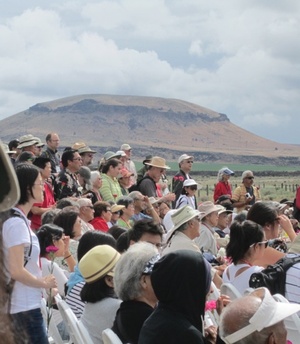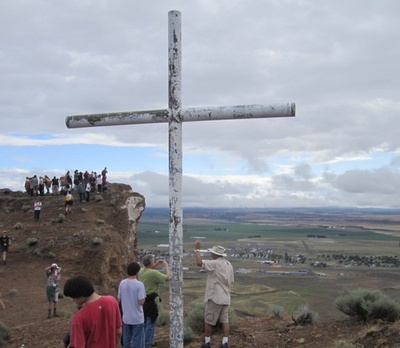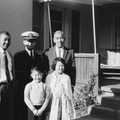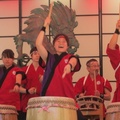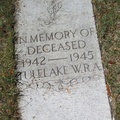Words can reveal truth or hide it. It is one thing when a poet employs unusual and imaginative phrases for artistic effect but quite another when the government uses euphemisms—the President, Congress, the courts, the army, the police—for it is certain that they do so to hide intent, deceive people, distort reality, and avoid responsibility. If the media passively accept these verbal distortions (or act to amplify them) public accountability becomes virtually impossible. And if corporate interests benefit from the lies, a profit motive will push them forward as well.
We should not allow them to get away with it.
Since 1975, the Tule Lake Pilgrimage (TLP) has focused on the experience of Japanese Americans (JAs) incarcerated at the Tule Lake concentration camp and then re-incarcerated in the Tule Lake Segregation Center during WWII. This paper deals with certain terms that have come up in our research and education efforts for the TLP. Some are War Relocation Authority (WRA) and government euphemisms; some are incorrect or inaccurately used terms; and some are terms commonly confused with or mistaken for similar or related terms.
While changing terminology is not an easy task, we believe that truth can prevail and that historical accuracy helps prevent the recurrence of injustice.
1. Aliens and Citizens: Forever Foreign
During WWII, the government went to great lengths to avoid saying they were undertaking the mass incarceration of US citizens without trial. In an extension of the terminology for denying citizenship to Asian immigrants, i.e. the Issei (first-generation Japanese Americans), they came up with even more convoluted terms to refer to their US citizen children, the Nisei (second-generation JAs).
Aliens Ineligible for Citizenship—The government term for Issei (immigrants from Japan), because they could not naturalize due to racist laws from our past.
- Naturalization Act of 1790 states “any alien, being a free white person who shall have resided within the limits and under the jurisdiction of the United States for a term of two years, may be admitted to become a citizen thereof”.
- Amendment of 1873 adds “persons of African nativity or descent” to the law, which still excludes other races, i.e. Asians.
- Supreme Court decision of 1922 upholds the act of 1790.
Non-alien—The government term for American-born citizens of Japanese descent, i.e. the Nisei. Citizens have inalienable constitutional rights; apparently, “non-aliens” do not.
2. Terms of Confinement: What’s in a Name?
The government, mainly through the US Army and the WRA, employed many euphemistic terms meant to imply a voluntary movement of people away from danger (e.g. evacuation) to a place of safety (e.g. assembly center, relocation center). These euphemisms should be replaced by historically accurate, fact-based terms.
a) Problematic and Euphemistic Terms:
Evacuation—The government euphemism for the forced removal of Japanese Americans from their homes, farms, businesses during WWII. Most JAs were locked in mass temporary detention facilities before being shipped under armed guard to more permanent concentration camps. “Evacuation” implies a mass movement of people away from danger to a place of safety. This was clearly not the case; use of the term masks the forced, involuntary nature of the move and the lack of any just cause for it.
Assembly Center—The government euphemism for a temporary detention center for Japanese Americans. Most were at racetracks or fairgrounds where horse stalls and exhibition halls were quickly converted to living quarters; most had inadequate cooking and sanitation facilities as well. “Assembly Center” implies a safe haven where people gather for shelter, but the reality was one of forced removal under armed guard to a site of mass imprisonment.
Relocation Center—The government euphemism for an incarceration camp, i.e. one of the ten large WRA concentration camps hastily erected in Arkansas, Arizona, California, Colorado, Idaho, Utah, and Wyoming. “Relocation Center” implies a benevolent government program to assist JAs in finding new housing. It fits in with government attempts to portray the wholesale removal of Japanese Americans from the West Coast to sites of mass incarceration as the creation of “pioneer communities” or safe havens “for their own protection” rather than the reality of large prison camps.
Confinement Site—A non-specific term (first used by the National Park Service) to encompass all facilities of any kind where Japanese Americans were held during WWII. These facilities were administered by the War Relocation Authority, the Department of Justice, the US Army, the Immigration and Naturalization Service, and local police, among others. Over 70 such sites have been identified as of July 2013.
b) Preferred Terms and Specific Situations:
Detention Center—A temporary (generally weeks to months) holding area for Japanese Americans during WWII. The WRA “assembly centers” would fall in this category, as would many of the Immigration stations and US Army camps that were used to temporarily house Nikkei (people of Japanese descent) before they were sent to more permanent facilities, such as DOJ internment camps or WRA concentration camps.
Concentration Camp—One of the ten large WRA camps, euphemistically called “relocation centers” by the government, set up to imprison Americans of Japanese descent without trial or due process. Neither the US Constitution, the Bill of Rights, nor the Geneva Conventions applied to those imprisoned in these camps. Most Nikkei were imprisoned here for one to four years and were confined solely by reason of race.
Incarceration Camp—WRA camp for holding Japanese Americans. An alternate term for concentration camp—see entry above.
Internment Camp—Department of Justice (DOJ) camps for “enemy aliens”, i.e. citizens of a foreign country with which the US was at war (i.e. Japanese, German, and Italian citizens). Inmates at these facilities were covered under the Geneva Conventions for prisoners of war. Issei would qualify as enemy aliens, but Nisei would not. Initially, those taken off to DOJ internment camps were almost all Issei, but later, “troublemakers” among both Issei and Nisei would sometimes be sent off to DOJ internment camps. Though this term is commonly used to refer to the large incarceration camps run by the WRA, such use is technically incorrect and feeds into the perception of JAs as “forever foreign” since only foreign nationals can be legally interned.
Segregation Center—The concentration camp at Tule Lake, CA, was selected as the site to segregate (i.e. isolate) Japanese Americans who answered the so-called “loyalty questionnaire” with unsatisfactory answers (i.e. those the WRA labeled as “disloyal”). Later, it was also used to segregate others the WRA identified as “troublemakers” or whose stated preference was to expatriate or repatriate to Japan.
* This paper is based on a PowerPoint presentation prepared for a workshop on The Power of Words: Coming to Terms with American Concentration Camps and the Japanese American WWII Experience at the Association of Asian American Studies National Conference held in Seattle, WA in April 2013.
© 2013 Stanley N. Shikuma


